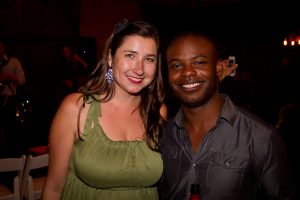Indian Traditional Music Begets American Minimalism
Western music has absorbed influences from other cultures at highly specific junctures. Mozart encountered Turkish Janissary music when he came to Vienna in 1781, and it found its way into his next opera’s percussion section. Debussy heard a Javanese gamelan at the 1889 Paris World Exhibition and it transformed his concept of harmonic progression.
When the American composer Philip Glass encountered the North Indian musical tradition through sitarist Ravi Shankar in 1960, the musical style we call Minimalism began to form in Glass’ musical imagination. On Tuesday (March 5) at the San Diego Museum of Art, the intrepid Art of Élan concert series offered a revealing tutorial in American Minimalism and traditional South Indian (Carnatic) music.
Glass’ Second String Quartet (titled “Company” after the Samuel Beckett play for which it was written as incidental music) opened the program, setting a canonic Minimalist ethos for the evening in the museum’s Hibben Gallery. The work’s four succinct movements pulsed high energy through static progressions and densely layered textures. I particularly enjoyed the second movement with its playful, unpredictable dynamic shifts.
Art of Élan Artistic Director Kate Hatmaker and Anna Skálová, violins, were joined by violist Gareth Zehngut and cellist Yao Zhao in a driving, cleanly articulated account of the Second String Quartet.
After clearing the gallery’s small stage of chairs and music stands, the three Indian musicians assumed their customary positions sitting cross-legged on the carpet. Vocalist Roopa Mahadevan proved the center of this Carnatic trio, spinning out her nasal-tinged vocal line as deft and sinuous as that of her violinist colleague Arun Ramamurthy’s fleet instrumental line.
Urging and quickening the pulse of this trio, Rajna Swaminathan’s percussion artistry on the mrudangam securely grounded the melismatic trance of the voice and violin. The mrudangam, a defining component of Carnatic music, is a drum played in horizontal position on the drummer’s lap so that each end—the bass and the treble end—can be played simultaneously. Compared to the steady pulsing that drums typically underscore in western music, the mrudangam performer is required to execute complex subdivisions and patterns that leave even our virtuoso timpanists noodling aimlessly by comparison.
As postlude to the 30-minute set of traditional Carnatic performance, Art of Élan offered Robert Aldridge’s 1987 “Threedance” for[php snippet=1] violin, marimba and tabla. Nicholas Terry’s delicately incisive marimba malletting evoked the serene ambience of a Javanese gamelan, allowing violinist Skálová to execute fluttering ostinatos in her highest register: tight, mysterious arabesques. Justin DeHart, an avid percussionist we typically hear on marimba and other mallet instruments, took his turn on tabla, making good use of his Fulbright Scholar year in India as a percussion student. His mesmerizing patterns kept the imaginary dervishes whirling.
[box] The next Art of Élan program will be given at the Lux Art Institute in Encinitas (www.luxartinstitute.org) on April 4, 2013, at 6:00 p.m. This program will feature flutist Demarre McGill playing the music of LJOVA and Arturo Marquez.[/box]

Ken Herman, a classically trained pianist and organist, has covered music for the San Diego Union, the Los Angeles Times’ San Diego Edition, and for sandiego.com. He has won numerous awards, including first place for Live Performance and Opera Reviews in the 2017, the 2018, and the 2019 Excellence in Journalism Awards competition held by the San Diego Press Club. A Chicago native, he came to San Diego to pursue a graduate degree and stayed.Read more…


I simply could not go away your website before suggesting that I extremely loved the usual info a person supply to your guests? Is gonna be back steadily to investigate cross-check new posts